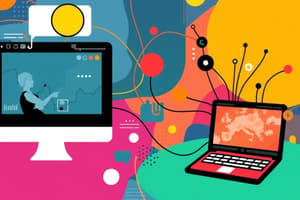Podcast
Questions and Answers
What is a significant negative effect of social media addiction?
What is a significant negative effect of social media addiction?
- Improved communication skills
- Better academic performance
- Increased physical activity
- Neglecting valued activities (correct)
What does FOMO stand for in the context of social media?
What does FOMO stand for in the context of social media?
- Fear of Making Offers
- Fear of Missing Opportunities
- Fear of Mediocre Outcomes
- Fear of Missing Out (correct)
How does multitasking with social media affect students' academic performance?
How does multitasking with social media affect students' academic performance?
- It enhances their ability to concentrate
- It improves their overall learning
- It significantly reduces their concentration (correct)
- It has no impact on their studies
What can frequent social media use reduce in terms of social interaction?
What can frequent social media use reduce in terms of social interaction?
Which of the following is NOT a negative effect of social media usage mentioned?
Which of the following is NOT a negative effect of social media usage mentioned?
Which action is advised to handle negative comments on social media?
Which action is advised to handle negative comments on social media?
What should be avoided when using social media to prioritize safety?
What should be avoided when using social media to prioritize safety?
What does technology literacy primarily enable an individual to do?
What does technology literacy primarily enable an individual to do?
Which of the following is NOT considered good information?
Which of the following is NOT considered good information?
What is disinformation?
What is disinformation?
How can the Internet both benefit and harm information sharing?
How can the Internet both benefit and harm information sharing?
Which website domain is most likely to be affiliated with a non-profit organization?
Which website domain is most likely to be affiliated with a non-profit organization?
What type of media includes newspapers and magazines?
What type of media includes newspapers and magazines?
What is the ethical use of information regarding credit?
What is the ethical use of information regarding credit?
Which characteristic is essential for assessing the authority of a webpage?
Which characteristic is essential for assessing the authority of a webpage?
What differentiates misinformation from disinformation?
What differentiates misinformation from disinformation?
What is a key factor to consider when determining the reliability of information from the internet?
What is a key factor to consider when determining the reliability of information from the internet?
Which of the following is considered a tertiary source of information?
Which of the following is considered a tertiary source of information?
What technological advancement characterized the Industrial Age?
What technological advancement characterized the Industrial Age?
Which of the following best describes the purpose of cross-referencing information sources?
Which of the following best describes the purpose of cross-referencing information sources?
What is one characteristic of pre-industrial media identified in the content?
What is one characteristic of pre-industrial media identified in the content?
Which publication would NOT be considered a reliable source of information?
Which publication would NOT be considered a reliable source of information?
During which period did the printing press using wood blocks emerge?
During which period did the printing press using wood blocks emerge?
Which of the following methods is effective in assessing the reliability of an online source?
Which of the following methods is effective in assessing the reliability of an online source?
What are technical codes primarily used for in media language?
What are technical codes primarily used for in media language?
Which of the following shot types focuses on the surrounding environment as well as the subject?
Which of the following shot types focuses on the surrounding environment as well as the subject?
What is a defining characteristic of an Extreme Close Up Shot?
What is a defining characteristic of an Extreme Close Up Shot?
Which shot type is best suited for dialogue scenes while still depicting body language?
Which shot type is best suited for dialogue scenes while still depicting body language?
In terms of camera technique, how does lighting function as a technical code?
In terms of camera technique, how does lighting function as a technical code?
Which shot would likely be used to emphasize a character's emotional reaction?
Which shot would likely be used to emphasize a character's emotional reaction?
What is the main purpose of using an Extreme Long Shot in a film?
What is the main purpose of using an Extreme Long Shot in a film?
What do technical codes include besides camera movements?
What do technical codes include besides camera movements?
What is the primary distinction between dolly and tracking shots?
What is the primary distinction between dolly and tracking shots?
Which camera movement is typically associated with introducing a character of grandeur?
Which camera movement is typically associated with introducing a character of grandeur?
What is the main function of a Steadicam?
What is the main function of a Steadicam?
What does a crane shot typically achieve in film?
What does a crane shot typically achieve in film?
The purpose of a POV (Point of View) shot is primarily to:
The purpose of a POV (Point of View) shot is primarily to:
Which of the following best describes the purpose of symbolic codes in film?
Which of the following best describes the purpose of symbolic codes in film?
What movement does panning involve?
What movement does panning involve?
Which statement is false regarding a pedestal movement?
Which statement is false regarding a pedestal movement?
Flashcards are hidden until you start studying
Study Notes
Definition of Technology
- Technology is the systematic application of art or skill for practical purposes.
Technology Literacy
- Involves the ability to responsibly and effectively use technological tools, both independently and collaboratively.
Media and Information Literacy
- Essential skills for engaging with media and information.
- Promotes critical thinking, lifelong learning, and active citizenship.
Information
- Defined as knowledge communicated or received regarding specific facts or circumstances.
Characteristics of Good Information
- Relevant, sufficiently accurate and complete, reliable, and appropriately targeted to the audience.
Assessing Information
- Evaluate by finding the page, checking the page's authority and updates, assessing accuracy and objectivity, and considering functionality based on domain (.org, .edu, .gov, .com).
Ethical Use of Information
- Credit sources appropriately, practice due diligence, respect privacy, and differentiate between facts and opinions.
Types of False Information
- Disinformation: False information created to harm.
- Misinformation: False information shared without intent to harm.
- Malinformation: Based on reality but used to inflict harm.
Responsible Use of Social Media
- Media acts as a communication channel for sending and receiving information.
- Prioritize safety by avoiding posting personal details and excessive private information.
- Promote good conduct and respond to negativity with positivity.
Negative Effects of Media Use
- Addiction can lead to neglecting important activities and relationships.
- Distraction from studies significantly reduces academic performance.
- Reduced social interaction may impair real-life communication skills.
- Fear of Missing Out (FOMO) creates anxiety about missing positive experiences.
- Media use can affect mood and stress levels, sometimes resulting in online arguments.
Determining Reliability of Information
- Check the author, publication date, citations, website domain, design, writing style, factual accuracy, and cross-reference with other sources.
Classification of Information Sources
- Types include journal articles, editorials, literacy criticism, book reviews, and textbooks.
- Tertiary sources compile or digest information, including encyclopedias and bibliographies.
Evolution of Traditional to New Media
- Pre-Industrial Age: Early uses of tools, writing systems (e.g., cave paintings, clay tablets, papyrus).
- Industrial Age: Introduction of machines and long-distance communication.
Media Language
- Comprises codes, conventions, and structures that convey meaning.
- Technical Codes include camera techniques, sound, and lighting.
Camera Shots
- Extreme Long Shot: Shows subject from a distance.
- Wide Shot: Displays the subject in relation to surroundings.
- Medium Shot: Focuses on subject’s body language and dialogue.
- Medium Close-Up: Captures facial expression with some background.
- Close-Up: Highlights details of the subject.
- Extreme Close-Up: Frames the subject closely, showing essential details.
Camera Movement Techniques
- Panning, tilting, dolly, tracking, pedestal, and crane shots affect storytelling and audience engagement.
- Steadicam enhances smoothness in camera movement for dynamic shots.
- POV (Point of View) shots present the character’s perspective, enhancing viewer immersion.
Symbolic Codes
- Reveal deeper meanings beyond visual presentation, including body language, setting, and color symbolism.
Studying That Suits You
Use AI to generate personalized quizzes and flashcards to suit your learning preferences.




